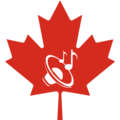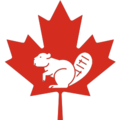Portal:Canada
| Showcase | Contents | Contributing |
Introduction
Canada is a country in North America. Its ten provinces and three territories extend from the Atlantic Ocean to the Pacific Ocean and northward into the Arctic Ocean, making it the world's second-largest country by total area, with the world's longest coastline. Its border with the United States is the longest international land border. The country is characterized by a wide range of both meteorologic and geological regions. With a population of over 41 million, it has widely varying population densities, with the majority residing in urban areas and large areas of the country being sparsely populated. Canada's capital is Ottawa and its three largest metropolitan areas are Toronto, Montreal, and Vancouver.
A developed country, Canada has a high nominal per capita income globally and its advanced economy ranks among the largest in the world by nominal GDP, relying chiefly upon its abundant natural resources and well-developed international trade networks. Recognized as a middle power, Canada's support for multilateralism and internationalism has been closely related to its foreign relations policies of peacekeeping and aid for developing countries. Canada promotes its domestically shared values through participation in multiple international organizations and forums. (Full article...)
Featured article -

*A: Cambridge
*B: Newburyport
*C: Fort Western
*D: Fort Halifax
*E: Great Carrying Place
*F: Height of land
*G: Lake Mégantic
This map does not accurately represent the area around the height of land and Lake Mégantic.
In September 1775, early in the American Revolutionary War, Colonel Benedict Arnold led a force of 1,100 Continental Army troops on an expedition from Cambridge in the Province of Massachusetts Bay to the gates of Quebec City. The expedition was part of a two-pronged invasion of the British Province of Quebec, and passed through the wilderness of what is now Maine. The other expedition invaded Quebec from Lake Champlain, led by Richard Montgomery. (Full article...)
Current events
- June 30, 2025 – 2025 United States trade war with Canada and Mexico
- National Economic Council director Kevin Hassett announces that the United States will restart trade talks with Canada after they cancel their digital services tax on American technology firms. (CBC)
- June 27, 2025 – 2025 United States trade war with Canada and Mexico
- U.S. president Donald Trump announces the suspension of the trade talks with Canada, also announcing new tariffs on goods crossing the Canada–United States border. (BBC News)
- June 26, 2025 –
- The bodies of three missing people are recovered after the June 20 crash of an Airmedic MBB/Kawasaki BK 117 in a lake shortly after takeoff from Havre Saint-Pierre Airport in Quebec, Canada. (CTV News)
- June 23, 2025 – Russian invasion of Ukraine
- NATO Secretary-General Mark Rutte announces that European countries and Canada will send Ukraine a combined aid package of €35 billion (US$40.3 billion). (RBC)
- June 20, 2025 –
- Four people are missing after a Kawasaki medical helicopter on a rescue operation crashes north of Baie-Johan-Beetz near Natashquan on the Côte-Nord in Quebec, Canada. The pilot is found and taken to hospital. (CBC)
- June 19, 2025 –
- A rockslide at Bow Glacier Falls near Banff, Alberta, Canada, kills at least two people. Three other hikers sustained injuries. (CFCN-DT)
Selected panorama -
National symbol -
In Canadian folklore, Mussie is a creature said to live in Muskrat Lake in the Canadian province of Ontario. It is variously described, for example, as a walrus or as a three-eyed Loch Ness Monster-like creature.The legend of Mussie likely began around 1916, though legend claims that Canadian pioneer Samuel de Champlain wrote about it in the early seventeenth century. Mussie has become a part of the local culture and a fixture in the local tourism industry. (Full article...)
Selected vital article -
The Canadian Charter of Rights and Freedoms (French: Charte canadienne des droits et libertés), often simply referred to as the Charter in Canada, is a bill of rights entrenched in the Constitution of Canada, forming the first part of the Constitution Act, 1982. The Charter guarantees certain political rights to Canadian citizens and guarantees the civil rights of everyone in Canada. It is designed to unify Canadians around a set of principles that embody those rights. The Charter was proclaimed in force by Queen Elizabeth II of Canada on April 17, 1982, as part of the Constitution Act, 1982. (Full article...)
Selected picture -
Featured biography -
Wayne Douglas Gretzky CC (/ˈɡrɛtski/ GRET-skee; born January 26, 1961) is a Canadian former professional ice hockey player and former head coach. He played 20 seasons in the National Hockey League (NHL) for four teams from 1979 to 1999. Nicknamed "the Great One", he has been called the greatest ice hockey player ever by the NHL based on surveys of hockey writers, ex-players, general managers and coaches. Gretzky is the leading career point scorer and assist producer in NHL history and has more assists than any other player has total career points. He is the only NHL player to total over 200 points in one season, a feat he accomplished four times. In addition, Gretzky scored more than 100 points in 15 professional seasons. At the time of his retirement in 1999, he held 61 NHL records: 40 regular season records, 15 playoff records, and six All-Star records. (Full article...)
Did you know -

- ... that the Saskatchewan Conservation House, built in 1977 to withstand Canadian winter temperatures, did not use a furnace?
- ... that the Manhattan Project feed materials program used uranium ore from a mine in Canada near the Arctic Circle?
- ... that Christ Church, Amherstburg, a Canadian church built by a Loyalist, features timbers fashioned after a ship's hull?
- ... that Jennifer Reid at first could not find a Canadian publisher for her book on Canadian identity?
- ... that Winter Renouf, a British member of the Indian Civil Service, thought that farmers in the Punjab should grow Canadian wheat varieties?
- ... that a 23-day CBC strike thrust Don Goodwin into the Canadian national spotlight and into "folk-hero status"?
- ... that Mount Churchill, a volcano in Alaska, distributed ash as far as Europe and may have driven migration from Canada to southwestern North America?
Featured list -
The 400-series highways are a network of controlled-access highways in the Canadian province of Ontario, forming a special subset of the provincial highway system. They are analogous to the Interstate Highway System in the United States or the Autoroute system of neighbouring Quebec, and are regulated by the Ministry of Transportation of Ontario (MTO). The 400-series designations were introduced in 1952, although Ontario had been constructing divided highways for two decades prior. Initially, only Highways 400, 401 and 402 were numbered; other designations followed in the subsequent decades. To this day, not all controlled-access highways in Ontario are a part of the 400-series highway network. The network is situated almost entirely in Southern Ontario, although Highway 400 extends into the more remote northern portion of the province. (Full article...)
Canadian content search
Associated Wikimedia
The following Wikimedia Foundation sister projects provide more on this subject:
-
Commons
Free media repository -
Wikibooks
Free textbooks and manuals -
Wikidata
Free knowledge base -
Wikinews
Free-content news -
Wikiquote
Collection of quotations -
Wikisource
Free-content library -
Wikiversity
Free learning tools -
Wikivoyage
Free travel guide -
Wiktionary
Dictionary and thesaurus






























